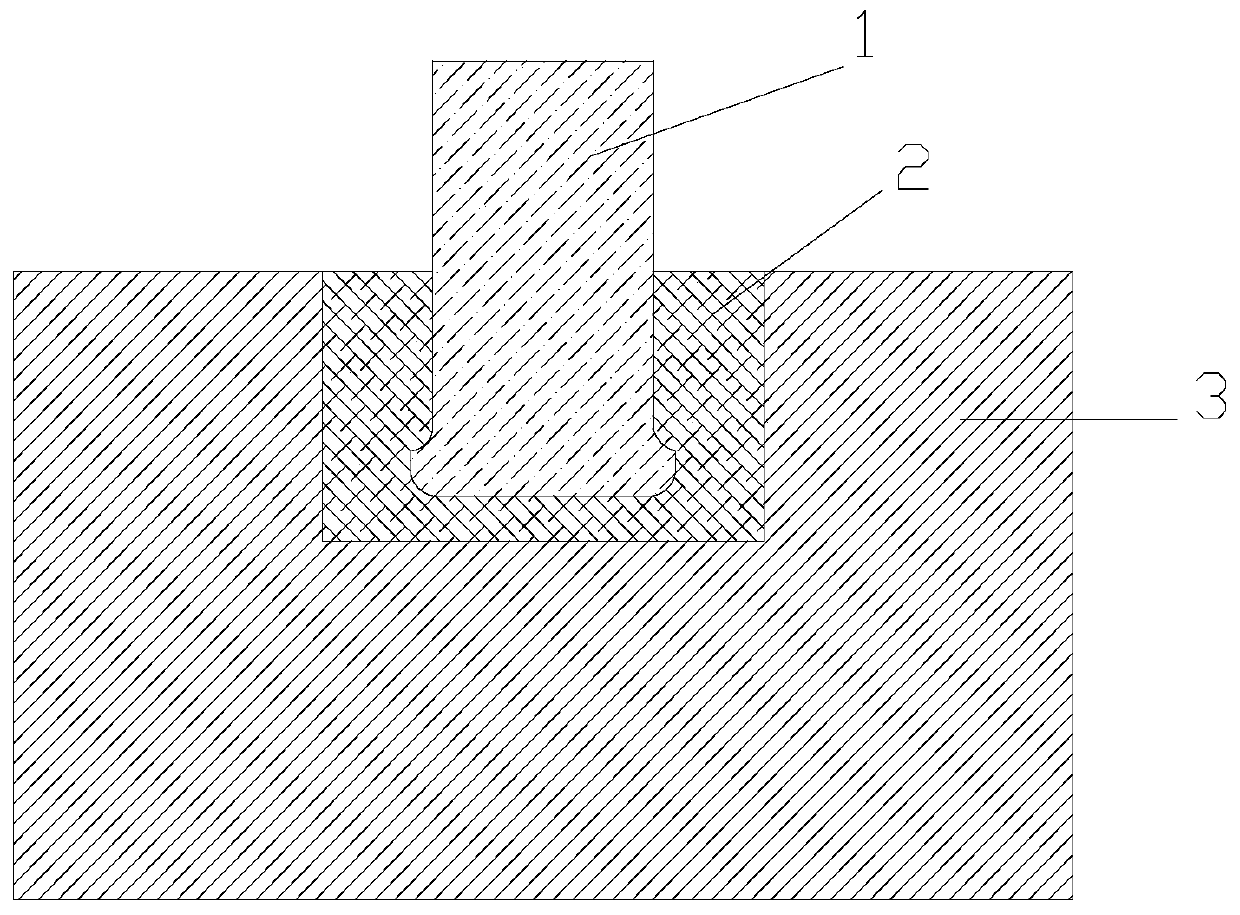A method for connecting a metal-ceramic inert anode to a metal conductive rod for aluminum electrolysis
An inert anode, metal conductive technology, applied in the field of aluminum electrolysis, can solve the problems of corrosion failure of the joint, electrical connection stability, difficulty in mutual diffusion of elements, cracks in ceramic materials, etc., to achieve good high temperature oxidation resistance, shorten the process flow, The effect of small resistance voltage drop
- Summary
- Abstract
- Description
- Claims
- Application Information
AI Technical Summary
Problems solved by technology
Method used
Image
Examples
Embodiment 1
[0025] NiFe used 2 o 4 The base cermet inert anode is composed of a ceramic phase and a metal phase, and the composition of the ceramic phase contains NiO 17% by mass percentage, and the rest is NiFe 2 o 4 ; The composition of the metal phase is 80Cu-15Ni-5Ag; the mass ratio of the metal phase to the ceramic phase is 17:83;
[0026] The material of the metal conductive rod is 2520 stainless steel;
[0027] The composition of the filler used is by mass percentage: NiFe 2 o 4 50% of ceramic particles, 10% of TiN nano powder, and 40% of metal powder; the metal powder is 60Cu-30Ni-10Ag mixed metal powder with a particle size of ≤100 μm; the NiFe 2 o 4 The particle size of the ceramic particles is ≤74 μm; the particle size of the TiN nano powder is 40-80 nm;
[0028] NiFe 2 o 4 The base cermet inert anode was pre-sintered at 900 °C for 6 hours, cooled to room temperature, and then in NiFe 2 o 4 Drilling holes on the inert positive surface of the base cermet;
[0029] Pu...
Embodiment 2
[0032] Method is with embodiment 1, and difference is:
[0033] (1) NiFe used 2 o 4 The base cermet inert anode does not contain NiO 4 ; The composition of the metal phase is 85Cu-15Ni; the mass ratio of the metal phase to the ceramic phase is 10:90;
[0034] (2) The material of the metal conductive rod is 80Ni-20Cr nickel-based superalloy;
[0035] (3) The composition of the filler used is by mass percentage: NiFe 2 o 4Ceramic particles 65%, TiN nano powder 25%, metal powder 10%; the metal powder is 80Cu-20Ni mixed metal powder;
[0036] (4) NiFe 2 o 4 The base cermet inert anode was pre-sintered at 1000°C for 5 hours;
[0037] (5) Metal conductive rod and NiFe 2 o 4 The minimum distance between base cermet inert anodes is 12.5mm;
[0038] (6) The connection structure material is kept at 1200° C. for 4 hours, and the oxygen partial pressure under the protective atmosphere is 50 Pa.
Embodiment 3
[0040] Method is with embodiment 1, and difference is:
[0041] (1) NiFe used 2 o 4 The composition of the ceramic phase in the base cermet inert anode contains NiO10% by mass percentage, and the rest is NiFe 2 o 4 ; The composition of the metal phase is 82.5Cu-15Ni-2.5Ag; the mass ratio of the metal phase to the ceramic phase is 14:86;
[0042] (2) The material of the metal conductive rod is K640 cobalt-based superalloy;
[0043] (3) The composition of the filler used is by mass percentage: NiFe 2 o 4 57% of ceramic particles, 18% of TiN nano powder, and 25% of metal powder; the metal powder is 70Cu-25Ni-5Ag mixed metal powder;
[0044] (4) NiFe 2 o 4 The base cermet inert anode was pre-sintered at 950°C for 4 hours;
[0045] (5) Metal conductive rod and NiFe 2 o 4 The minimum distance between base cermet inert anodes is 20mm;
[0046] (6) The connection structure material is kept at 1150° C. for 5 hours, and the oxygen partial pressure under the protective atmosp...
PUM
| Property | Measurement | Unit |
|---|---|---|
| particle diameter | aaaaa | aaaaa |
| particle diameter | aaaaa | aaaaa |
| particle diameter | aaaaa | aaaaa |
Abstract
Description
Claims
Application Information
 Login to View More
Login to View More - R&D
- Intellectual Property
- Life Sciences
- Materials
- Tech Scout
- Unparalleled Data Quality
- Higher Quality Content
- 60% Fewer Hallucinations
Browse by: Latest US Patents, China's latest patents, Technical Efficacy Thesaurus, Application Domain, Technology Topic, Popular Technical Reports.
© 2025 PatSnap. All rights reserved.Legal|Privacy policy|Modern Slavery Act Transparency Statement|Sitemap|About US| Contact US: help@patsnap.com

